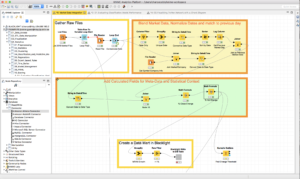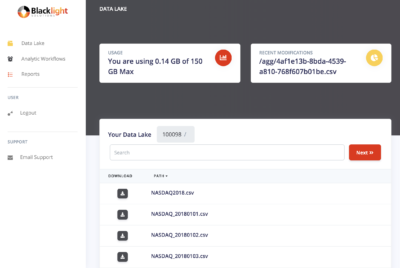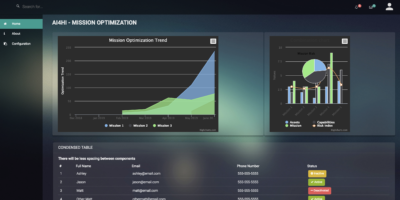From Services Provider to Software Vendor
Your service is successful. You are fulfilling the needs of your customers. Your reputation is healthy, and now you are looking to expand more. The most basic expansion strategy is asking what else you can do for your existing customers to strengthen your relationship.
Offering a software product is a clear win. With the data your service creates you could put analytics and dashboards in front of your customers, or perhaps offer them more customized and premium experiences based on the details of your relationship. Once you reach that conclusion, you need a method for getting it together and in front of them. At that point the challenges can seem daunting. Adding a software capability to your services business can feel out of reach because of the complexity and investment involved. Surprisingly, the key to success is speed in execution.

How do you put together a web portal, mobile app or even just a system for create tailored messaging for your customers? The most common thinking is that it requires hiring software developers to get started and focus on their development activities. Unfortunately, that is an expensive proposition and misses the necessary strategy to succeed. Many smaller businesses that head down this path are taking a stab in the dark. They haven’t developed a clear strategy for creating exciting content for their customers. They have leapt from their deep and intuitive understanding of their customers to attempting to find a few or even a single software developer that can fill in the blanks for them. Expanding your team is a healthy move to add capacity, but you need to be perfectly clear about what you want to do and how it is going to win. Too often we see companies asking for help a year or two after this point when the potential of this moment has imploded into frustration. What you need is the right combination of tools and skills to help you focus on putting exciting new content in front of your customers that enables new sales or engagement.
Surprisingly, the key to success is speed in execution
A platform that supports you should focus on clearing the path to the successful deployment of software to your customers. This deployment starts with a strategic pipeline for the creation of that software. As your ideas evolve, your pipeline should support adaptively changing your software incrementally to keep the flow of updates frequent and consistent. That pipeline will consist of three components.
First, you need a code way to grab data, clean, blend and analyze it. We focus on code-free tools because you don’t want to depend solely on a single developer and their technology stack to get things done at this stage. We use the term code-free to refer to tools that allow deep technology to be built and integrated as code when necessary but are free from constraining you to any particular technology as your ideas take shape. We write code-free to imply freedom of choice in when to use code, not to exclude it as an option. The burden on this tool is high. It must connect, integrate to a variety of sources for data in a graphical and easy to use way. It must allow operations on that data and blend multiple data sources. It must also allow any analyst to use more advanced analytics to enrich the data based on statistics or even the contents of a block of text.

Next a data lake to deposit the data, govern it and make it accessible to the appropriate people. The data lake must support both structure and unstructured data. The data lake should also scale in both space (the amount of data you can put in it) and space (the amount of compute power required to crunch and refine that data). Even more, the analytics developed in the tool described above should be able to be run directly in your data lake as part of the infrastructure. Trying to move data in and out of your lake will be intractable as your data variety, velocity and volume grow. You need to be able to run those workflows and perform your processing inside of the data lake.
Finally, you will need a presentation layer to create the content for your customers. This is the most important piece because this is where you create the experience for your customers and the content you are sharing. The presentation of the content can take the form of personalized messaging, a web or mobile application that provides a custom experience or even simple dashboards that show them trends on what they want to see. One of the advantages of modularizing your content production like this is that you can publish the content in any of these modalities and even change your mind later on. Much of the hard work is getting the data together, processing it and preparing it to drive your offering. All of that is part of your intellectual property now and should be protected regardless of how you present the content. When you do choose a way to present, you can adjust the depth of your investment, frequency of publication and complexity of the experience for your customers accordingly.

The simplest and probably lowest investment you can make is to embed a business intelligence tool that provides you with the ability to style the tool and publish dashboards directly to your customers. Many tools in this market provide “embedded” functionality like this and have agreements that you can use to become a specialized reseller of their software. Evaluating this software and determining the right course for the agreement with the vendor can be complex, which is why our firm offers consulting specifically on these points. We have negotiated dozens of these agreements (from both sides of the table) and are deeply familiar with the nuances of the market.
Alternatively, some firms like to create a highly customized experience to maintain more fine-grained control of their brand and to invest more heavily in their intellectual property. Fortunately, plenty of templates exist which allow for the rapid creation and deployment of web applications which automatically adjust their look and feel when being viewed over a mobile-devices. These allow you to get going quickly with branded screens and to begin iterating on them as the portal your customers can log into for a custom experience.

When looking for a way to create software for your customers time to market is the key criterion. You want to be able to create quality experiences for your customers without getting bogged down in technology resources and struggles. Find a platform that enables speed of execution and allow your ideas to breath and grow incrementally as you learn what works.





